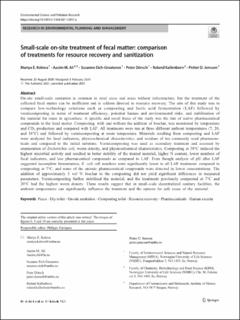| dc.description.abstract | On-site small-scale sanitation is common in rural areas and areas without infrastructure, but the treatment of the collected fecal matter can be inefficient and is seldom directed to resource recovery. The aim of this study was to compare low-technology solutions such as composting and lactic acid fermentation (LAF) followed by vermicomposting in terms of treatment efficiency, potential human and environmental risks, and stabilization of the material for reuse in agriculture. A specific and novel focus of the study was the fate of native pharmaceutical compounds in the fecal matter. Composting, with and without the addition of biochar, was monitored by temperature and CO2 production and compared with LAF. All treatments were run at three different ambient temperatures (7, 20, and 38°C) and followed by vermicomposting at room temperature. Materials resulting from composting and LAF were analyzed for fecal indicators, physicochemical characteristics, and residues of ten commonly used pharmaceuticals and compared to the initial substrate. Vermicomposting was used as secondary treatment and assessed by enumeration of Escherichia coli, worm density, and physicochemical characteristics. Composting at 38°C induced the highest microbial activity and resulted in better stability of the treated material, higher N content, lower numbers of fecal indicators, and less pharmaceutical compounds as compared to LAF. Even though analysis of pH after LAF suggested incomplete fermentation, E. coli cell numbers were significantly lower in all LAF treatments compared to composting at 7°C, and some of the anionic pharmaceutical compounds were detected in lower concentrations. The addition of approximately 5 vol % biochar to the composting did not yield significant differences in measured parameters. Vermicomposting further stabilized the material, and the treatments previously composted at 7°C and 20°C had the highest worm density. These results suggest that in small-scale decentralized sanitary facilities, the ambient temperatures can significantly influence the treatment and the options for safe reuse of the material. | |
